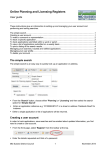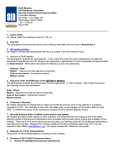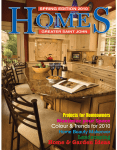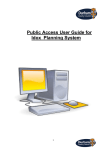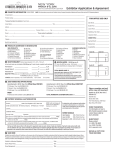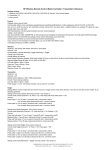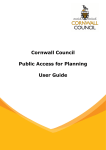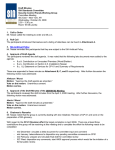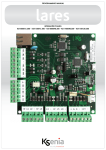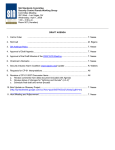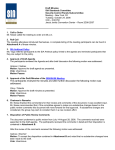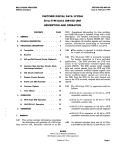Download Agenda_2008-10-29 - Security Industry Association
Transcript
SIA Standards Committee Security Control Panels Working Group Committee Meeting ISC East – New York, NY Wednesday, October 29, 2008 2:00 – 3:30 p.m. Room 1E-08 (Javits) DRAFT AGENDA 1. Call to Order ........................................................................................................ T. Nesse 2. Roll Call ........................................................................................................ M. Rigano 3. SIA Antitrust Policy ....................................................................................................... T. Nesse 4. Approval of Draft Agenda.............................................................................................. T. Nesse 5. Approval of the Draft Minutes of the 2008/04/02 Meeting............................................. T. Nesse 6. Chairman’s Remarks ................................................................................................... T. Nesse 7. Security Industry Alarm Coalition (www.siacinc.org) Update ....................................... R. Walters 8. Requests for CP-01 Interpretations .............................................................................. All 9. Revision of CP-01-2007 Discussion Items.................................................................... All a. Review of Highlighted Issues (see attachment) i. Contribution on Lightning and Thunder .......................................................... F. Clark ii. Contribution on Zone Type Definition ............................................................. R. Hinkson b. Ratification of Disposition of Items 10. Proposal for Security Industry Glossary Development Project ..................................... T. Nesse a. Update on October 16 Teleconference b. Review of Terms (http://spreadsheets.google.com/ccc?key=pqqV5kSTN3DzIj7LfdsdpCg&hl=en) 11. Next Meeting and Adjournment .................................................................................... T. Nesse Agenda Item 9.a – CURRENT REVISION LISTING TO THE ANSI/SIA CP-01:2007 STANDARD Highlights in Green reflect the disposition from the 4/2/2008 meeting. Commentor ADT Comment 4.2.7 Manual Alarms(third bullet) - Request for Elimination of Single Button Remote Services Disposition Proposed text: 4.2.7 Initiation of Manual Alarms Alarms that are manually initiated at an arming station shall require a double action trigger. A single button which must be held to initiate the manual alarm does not comply with this requirement. NOTE: Implementation of this feature may include, but is not limited to, any of the following: • Simultaneous depression of two buttons, where if either of the buttons have multiple functions, the two buttons are non-adjacent. (i.e., can’t be pressed with one finger) • Depression of a single button after lifting the cover that normally protects it, if the cover protects only emergency function buttons. • Depression of a single button for at least two seconds. Discussion at meeting: Dual buttons adjacent to each other (ADT - Bernie W.) to have a partition btw the two buttons to prevent a single activation. (SIAC - Ron W.) Does this help? Do we have data to show that it was not effective (DSC – Kevin H.)? Bernie / Hinkson Motion to approve the addition with the clarification above. Unanimous Consent Disposition - Advanced into the final draft ADT ADT 4.3 Sensor Caused False Alarms To reduce the incidence of false alarms caused by sensors and/or system field wiring, the following shall be required. 4.3.4 Lightning and Thunder The control panel shall accept an electronic input (trip) from an external lightning sensor that detects nearby strikes and suppresses the processing of any alarm signal inputs that may occur during a period starting with the receipt of the signal from the sensor and extending for a period of 8 (eight) to 16 (sixteen) seconds thereafter. The suppression time interval may be fixed or programmable and at the conclusion of the time interval, the panel shall return to the normal operation required in the CP01 Standard. 4.1 Partitioned Systems Partitioned systems shall provide the requirements of Clause 4.2 User Caused False Alarms, 4.3 Sensor Caused False Alarms, and 4.6 Installation and Test for each partition. Each partition needs to be able to support the requirements in Clause 4. In testing, it will be acceptable to test 2 partitions as indicative of the product's ability to meet the requirements in all partitions. 4.1.1 Independent Partitions – Option If the system user operates a partitioned system, with each partition being operated independent of each other, there shall be a system option indicating this manner of behavior. When enabled each partition shall behave as if there were no other partitions, incorporating all of the features of this standard. If not enabled, then when a partition is armed and/or disarmed all partitions take on the state said partition. ADT Honeywell IDS Research & Add Annex D (informative) Recommended Self Validation Procedures The following procedures are intended to ascertain compliance with the requirements of the Security Industry Association’s Control Panel Standard - Features for False Alarm Reduction. These procedures are intended for use by the manufacturer to validate their design and for use by UL or other NRTL to confirm compliance. “We would like to see the inclusion of Nationally Recognized Testing Laboratories added as valid testing agents for the CP-01 standard.” 3.2.2 Agreed See Attachment B of the minutes for further clarification of the language. Discussion at meeting: This was discussed and considered fairly substantial as it requires an input definition on a panel for an undefined sensor. Defining the operational aspects of a sensor to aid in this? Some of the participants spoke in favor of making this and optional feature and wording that is less specifc. Mr. Clark will draft a contribution to that effect. The participants discussed ADT’s contribution and accepted it, with one slight modification to the contribution. Under 4.1.1 of the contribution last sentence; change end of sentence to read “state of said partition”. It was also noted that section 4.1, the auto stay feature could cause some confusion with partition systems and that this should also be reworked. Ted proposed that this be reworked offline as an assignment to submit a contribution. Terry Shelton, DMP and Bernie Worst, ADT agreed to take that action item. Remote arming hasn’t been a part of the discussion before and so that will need to be addressed. Guided the participants that the panel needs to distinguish btw. local arming, communication, etc. but not have it autostay. UL looks at the area system / commercial application may not be a perimeter. Want to make sure that 4.1.1 helps this. Agreed Agreed Agreed Development IDS Research & Development IDS Research & Development IDS Research & Development 24-hour alarm A zone that is always active usually for smoke detectors and or other types of life safety initiating detection devices. Reason for change: Clarification 3.2.9 arming station the part(s) of a security system from which a human operator can manually Arm and Disarm the system, manipulate the system operation, or otherwise interact with the system. Reason for change: Clarification 3.2.19 credential any piece of authoritative information that is related to a specific individual and can be used to identify them. A credential is normally used to allow only authorized individuals the ability to gain admission through a portal in a facility. Reason for change: Without the wording “authoritative” “in this definition, the wording “any piece of information” does not adequately amplify the importance of the “credential” The other changes are added for clarification and intent. 3.2.24 Duress A duress signal is activated by a user when they feel threatened due to one or more persons trying to force an individual to enter or re-enter a premise so that they can commit some criminal act against the property, the person, or both. Reason for change: The existing language is too limited and does clearly address what can occur as a result of a duress signal being transmitted to persons, property, or both. IDS Research & Development IDS Research & Development IDS Research & Development 3.2.30 fire alarm verification an operation that helps ensure Reason for change: Clarification 3.2.31 fire zone a zone or circuit installed upon which sensors are designed to detect a fire condition (e.g. smoke, heat, carbon monoxide, etc.) Apparent typographical error. 3.2.44 Panic A general type of perceived emergency, by the Agreed Agreed Discussion as to whether or not the text should read as follows: Duress A duress signal is activated by a user when they feel threatened due to one or more persons trying to force the user to enter or re-enter a premises. so that they can commit some criminal act against the property, the person, or both. Ader / Harris Motion to approve the text as presented above. Unanimous Consent Agreed Agreed Agreed that there was a need for clarification such as: user Reason for change: Clarification IDS Research & Development 3.2.58 transmission an electronic message sent from the control panel to the central station or remote station. IDS Research & Development Reason for change: Clarification 3.2.63 violated At the end of the sentence add; of the security system. IDS Research & Development Reason for change: Clarification 3.2.66 zone type a groups of zones identified by common attribute, function, or operating mode. IDS Research & Development IDS Research & Development Reason for change: Clarification 4.2.1 Second sentence The control panel shall support annunciation of exit and entry time in multiple keypad locations within the premises. Reason for change: Existing verbiage does not address what particular component will initiate annunciation. 4.2.2.2 Within the fourth paragraph “invoked” should read “enabled” “A general type of user perceived emergency.” “A general type of alarm initiated by a person in response to a threat.” Hinkson / Harris Motion to accept the definition Unanimous consent. Agreed Agreed Agreed that there is a need for a slight modification. Rich Hinkson will attempt to provide a contribution Committee agreed that it was outside the scope of the standard to indicate how the annunciation will occur. Did not agree with the comment. No change. Committee did not agree with the comment as it is the end user that invokes and the installer ‘enables’. No change. Reason for change: Technical accuracy IDS Research & Development IDS Research & Development IDS Research & Development 4.2.2.3 Within the second paragraph “invoked” should read “enabled” Reason for change: Technical accuracy 4.2.2.4 First paragraph E/E should read Exit/Entry Reason for change: Clarification 4.2.2.4 Exit error At the last marked bullet add at the end of the sentence message to the remote station. Committee did not agree with the comment as it is the end user that invokes and the installer ‘enables’. No change. Agreed Agreed IDS Research & Development Reason for change: Clarification 4.2.3.2. In the first sentence should read; Committee did not agree with the comment. A distinct annunciation shall be produced from all system keypads Reason for change: Clarification At the end of the first paragraph should read; needs to be audible at least 75db to a minimum IDS Research & Development Reason for change: So the manufacturer understands the level of audibility required by the standard. 4.2.4.1 At the end of the second paragraph should read; Second comment committee did not agree with the comment. Out of scope of the standard. Agreed and how it helps minimize inadvertent activation. IDS Research & Development Reason for change: Clarification 4.2.5.1 At the end of the first paragraph should read; Under no circumstances shall an Abort Window be provided where compliance with NFPA standards is required. IDS Research & Development IDS Research & Development Reason for change: The existing verbiage is not strong enough to amplify the criticality of always complying with NFPA standards where required. 4.4.3 At the end of the first paragraph delete the last sentence; Committee will review again with NPFA requirements. No decision made. Staff will ask the commentor to clarify what specific NFPA requirement is being referred to in the comment. The panel arming state shall be retained no less than fourteen (14) days during a power loss. Committee did not agree with the commentor. Was discussed extensively by the committee and noted that this was not the intent to have operational for 14 days; just the arming state. No change. Reason for change: This existing verbiage is confusing and may be interpreted to indicate that the control panel set will operate on a secondary battery for (14) days versus the intended purpose of the entire text. 4.6.1 Quick Reference At the second paragraph under the NOTE should read; Committee had concern with changing text that would go into manuals; no decision made. “There is a communicator delay of 30 seconds in the control panel of the alarm system. In other words, if your burglar alarm activates and it is being monitored by a remote station, the system will not attempt to contact the remote station until the alarm has been sustained for a period of 30 seconds. This feature can be disabled in system programming, or, extended at the option of the end user after consulting with the installer. All Further clarification must be done. “The user manual must contain a note that describes the following characteristics:…….list them” Mr. Nesse took the action item to draft a contribution. changes by the end user must be made in writing to the installer. IDS Research & Development Reason for change: The existing verbiage is not clear to an end user and we need to help minimize the installing dealer’s liability by adding this clarification and requiring that changes to the system be made in writing. 4.6.7.1 In the first sentence should read; Agreed A audible warning, IDS Research & Development Reason for change: The existing verbiage does not clarify if the warning is audible, or visual, or both. 4.6.7.2 The following sentence should be deleted; Committee did not agree with the commenter. No change. Should a point in a 24 hour alarm zone be in violation at the termination of a test, the panel shall suppress the alarm and treat the zone as a trouble condition. Reason for change: The existing verbiage will create increased liability for the installer, especially if no one follows up on this condition. Clearly, if the system is off-test, before leaving, the installer should have already ensured that all initiating detection devices have restored to their normal state of functionality. The following sentence should be modified as follows; The standard does not prohibit the annunciation and/or the reporting of fire alarm or trouble signals to a remote station during a test mode if they are not part of the test. NBFAA / Rick Simpson NBFAA / Rick Simpson NBFAA / Rick Simpson Reason for change: To help minimize liability, especially where life safety and property protection is at stake.” Communication Section - All controls panels shall be defaulted by Manufacture to auto start a 28 day test signal. This signal will first start after leaving programming of control panel and continue every 28 days thereafter. If the panel is for commercial use an option shall be added to have the test transmit daily. Line Trouble - In the event the line monitoring is enabled the default monitoring time needs to be set at 300 seconds. The length of time is needed to allow for certain phone providers to complete their maintenance cycle without causing a trouble signal to transmit to the central station. Radio Test Events (Add under Communication Section 4.6.3) - The radio unit shall be capable of This is a performance vs. a false alarm issue and outside the scope of the standard. No change. Committee needs more input. UL 864 says no. Where does the 300 number come from? Committee discussed and stated that this was out of scope. Harris / Patterson Motion that it is out of scope. Unanimous consent Comment Rejected the comment. Committee agreed that this was outside the scope of the standard. No NBFAA / Rick Simpson delivering a timer test from the control panel in the event of a loss of phone line. Default Armed to Stay Mode (4.2.4.1) Modify Consumers are routinely arming to stay without knowledge of bypassing interior detection. Add descriptive text asking client to press a keystroke to arm an interior device. NBFAA / Rick Simpson Changed zone bypass from 48 to 24 hours Vector Security “We request that the committee review adding Central Station response procedures for designated event codes generated as a result of CP-01 control panel standards. Currently these events are reporting to Central Stations who have no direction on how to respond. The events will result in dispatches without clear direction on the response protocol from a standards document.” change. Committee needs more input. Auto stay option is defaulted on. Further clarification needed. Martin / Clark Motion to make no change Unanimous Consent. Comment Rejected the comment. No rational presented. Committee will not take further action until such rationale is presented. Committee agreed that this is outside the scope of the standard and that it should be part of Central Station procedures. Agenda Item 9.a. i – Suppression of Lightning Generated False Alarms 04/08/08 fbc 4.3.4 Lightning and Thunder The control panel shall accept an electronic input (trip) from an external lightning sensor that detects nearby strikes. This trip will maintain a ground (0 volt) level in the idle condition and float (open circuit) when active. And The receipt by a control panel of a trip from a lightning sensor shall suppresses the processing of any alarm signal inputs that may occur during a period starting with the receipt of the signal (trip) from the sensor and extending for a period of 8 (eight) to 16 (sixteen) seconds thereafter. The suppression time interval may be fixed or programmable and at the conclusion of the time interval, the panel shall return to the normal operation required in the CP01 Standard. Note: The UL testing which is needed to provide listing of panels with this feature shall include verification that the time interval of shutdown is in accordance with the standard requirement. The detection characteristics of the sensor shall require a separate standard that is not part of the control panel standard. Agenda Item 9.a.ii – Rich Hinkson – 4/03/2008 Zone Type: An identifier for a set of attributes that define how a zone will respond to various changes in its inputs. An example of an attribute is the response to a short when the system is in a disarmed state Examples of zone types are Fire, Interior Burglary, Perimeter Burglary, etc. Agenda Item 10.a. Report on 2008/10/16 Ad Hoc on CP Glossary Teleconference (3:00-4:30 pm Eastern) The teleconference participants were: Sequel Technologies / Ted Nesse Tyco / Carl McGrath Tattletale / Frank Clark Honeywell / Rich Hinkson The participants briefly discussed the challenges associated with a SIA-wide glossary effort and the question was posed on whether or not the glossary was considered normative or informative. The document could potentially: - want it to “stand on it’s own” want to reference from other standards making it normative will result in this document being a higher maintenance activity Ted proposed to target a normative document Carl suggested new terms can be put in new standards, and then those terms can be moved into the glossary Frank was tending toward issuing the work as a reference document (informative) a new or revised standard would have the option to use a glossary term “as is”, or redefine a term in the new standard – later, the glossary can be evaluated to decide if the new definition can be accepted, or if two should be shown in the document The participants then reviewed the terms to date http://spreadsheets.google.com/ccc?key=pqqV5kSTN3DzIj7LfdsdpCg&hl=en Mr. Nesse asked the participants if there were any other additional terms to be added to the candidate listing. None were noted, however, as the participants began to review the list, additional ones were considered. The document is tracking the term resolution to date. Security Industry Glossary Project - Candidate Terms for Inclusion in the Industry Glossary term source abort abort window added by status ACK alarm signal UL 1023 8/30/01 ANI APCO Int'l annunciator UL 1023 8/30/01 arm ANSI/SIA CP-012007 (defined as close) T. Nesse included, to be defined T. Nesse included, to be defined T. Nesse included, to be defined a period of time after a sensor initiated alarm condition that allows the user additional time to disarm the system before an alarm is transmitted acknowledgment, a return signal indicating correct receipt of a transmitted revised and accepted at 2 Apr 08 meeting message at 2 Apr 08 meeting coded "M", noted "multiple An audible signal indicating an alarm condition requiring immediate action, such as an alarm initiated from an intrusion detector, door switch, floor mat, orseparation", at 16 Oct 08 meeting this term was accepted to be included and defined the like. T. Nesse Automatic Number Identification. the calling party’s telephone number included, to be defined T. Nesse included, to be defined committee included, to be defined armed, away T. Nesse armed, full T. Nesse included, to be defined ANSI/SIA CP-012007 ANSI/SIA CP-012007 included, to be defined T. Nesse included, to be defined T. Nesse included, to be defined ASCII APCO Int'l T. Nesse authentication DC09-2007 T. Nesse bypass ANSI/SIA CP-012007 (modified) meeting, 2 Apr 08 group armed, stay caller ID last update: 16 Oct 08 notes proposed at 2 Apr 08 meeting, 16 Oct 08 meeting this term was accepted to be included and defined accepted at 2 Apr 08 meeting committee included, to be defined ANSI/SIA CP-012007 DC09-2007 armed, home definition included, to be defined included, to be defined T. Nesse included, to be defined accepted at 2 Apr 08 meeting An externally-connected electrically operated visual indicating device containi accepted at 2 Apr 08 meeting one or more identified targets or indicator lamps in which each target or lamp indicates the circuit condition, location, or both. the act of arming a security system added and accepted at 2 Apr 08 meeting an armed state of a security system where all zones and sensors are activatedat 2 Apr 08 meeting: define 3 possible arming states: away, stay, full - cast a wide net, at 16 Oct 08 meeting this term was accepted to be included and defined "armed, away" is preferred accepted 16 Oct 08 "armed, stay" is preferred accepted 16 Oct 08 an armed state of a security system where some zones or sensors are active at 2 Apr 08 meeting: define 3 possible arming states: away, stay, full - cast a wide net, at 16 while other zones or sensors are made inactive, allowing occupants to be Oct 08 meeting this term was accepted to be inside the protected premises without causing an alarm included and defined American Standard Code for Information Interchange (ASCII): Standard code accepted at 2 Apr 08 meeting for a character set to be used for information interchange and data communications over telephone lines. In the context of TTY, ASCII refers to a binary code and a modulation method used for 110/300 baud TTY communications. A process to assure that a received message is not a counterfeit sent by an accepted at 2 Apr 08 meeting unauthorized sender. an operation to temporarily disable a point of protection (window, door, etc.) accepted 16 Oct 08 from performing its intended function at the time of arming the system included, to be defined T. Nesse included, to be defined T. Nesse included, to be defined committee included, to be defined committee included, to be defined see "ANI" ANSI/SIA CP-012007 communicator delay ANSI/SIA CP-012007 control ANSI/SIA CP-012007 cross zoning ANSI/SIA CP-012007 T. Nesse included, to be defined T. Nesse included, to be defined T. Nesse included, to be defined T. Nesse included, to be defined the part of the security system that sends electronic data outside the premises,accepted at 2 Apr 08 meeting typically to a central station a period of time which elapses before the communicator sends a transmissionrevised and accepted at 2 Apr 08 meeting to the central station - also see Abort Window the part of the security system that determines the operation and interaction ofaccepted at 2 Apr 08 meeting the system based on programmed logic a configuring of logic within the control panel such that two or more zones of accepted at 2 Apr 08 meeting the security system are interdependent in causing an alarm condition delayed zone T. Nesse a zone or circuit configured to provide a time delay, when tripped, before an accepted at 2 Apr 08 meeting alarm is generated, also see "exit delay", "entry delay" to turn off a security system accepted at 2 Apr 08 meeting cancel central station receiver closing report ANSI/SIA CP-012007 DC09-2007 closing signal communicator disarm ANSI/SIA CP-012007 ANSI/SIA CP-012007 included, to be defined T. Nesse included, to be defined added at 2 Apr 08 meeting a transmission indicating that the previous alarm signal, or alarm in process, isaccepted at 2 Apr 08 meeting to be disregarded A central station receiver accepts connections from premises equipment, for accepted at 2 Apr 08 meeting the purpose of transmitting event information to the central station. message to C/S, preferred over "signal" added, accepted 16 Oct 08 16 Oct discussion - this is an event report to the central station, not ringback proposed at 2 Apr 08 meeting, accepted 16 Oct 08 distinctive audible signals UL 1023 8/30/01 T. Nesse double action trigger ANSI/SIA CP-012007 duress ANSI/SIA CP-012007 T. Nesse encryption DC09-2007 T. Nesse end-of-line resistor UL 1023 8/30/01 entry delay ANSI/SIA CP-012007 entry time entry/exit zone exit delay ANSI/SIA CP-012007 ANSI/SIA CP-012007 exit delay exit error exit time false alarm fault included, to be defined T. Nesse included, to be defined included, to be defined T. Nesse included, to be defined T. Nesse included, to be defined T. Nesse programmed time of the entry delay revised and accepted at 2 Apr 08 meeting a delayed zone on the perimeter of the protected premises accepted 16 Oct 08 T. Nesse T. Nesse T. Nesse T. Nesse ANSI/SIA CP-012007 UL 985 3/4/04 T. Nesse T. Nesse fault fire alarm verification ANSI/SIA CP-012007 T. Nesse fire alarm verification UL 985 3/4/04 T. Nesse fire zone ANSI/SIA CP-012007 ANSI/SIA CP-012007 T. Nesse ANSI/SIA CP-012007 ANSI/SIA CP-012007 ANSI/SIA CP-012007 APCO Int'l T. Nesse follower zone holdup instant zone key fob keyholder local alarm ANSI/SIA CP-012007 revised and accepted at 2 Apr 08 meeting Signals obtained from different sounding appliances, such as bells, horns, sirens, and buzzers, or from a single appliance, such as an electronic horn, where a continuous signal is obtained under one condition and a pulsing signal under another. a manual operation that requires two simultaneous or sequential actions accepted 16 Oct 08 the presence of one or more persons trying to force an individual to enter or renote from 2 apr 08 meeting: use CP01 enter a facility, or commit some other act or action against the individual's will definition (which is already shown here), considered accepted The process of obscuring the content of a message so it can not be read by accepted 16 Oct 08 unauthorized persons. A resistor installed at the end of an initiating or indicating device circuit to limit accepted 16 Oct 08 the amount of supervisory current. the period of time allowed, after entry to the premises, to Disarm the security accepted at 2 Apr 08 meeting system before the panel initiates an Alarm Transmission Sequence T. Nesse ANSI/SIA CP-012007 included, to be defined included, to be defined included, to be defined included, to be defined included, to be defined included, to be defined included, to be defined included, to be defined included, to be defined included, to be defined included, to be defined included, to be defined included, to be defined T. Nesse included, to be defined T. Nesse T. Nesse T. Nesse T. Nesse included, to be defined included, to be defined included, to be defined included, to be defined included, to be defined accepted 16 Oct 08, but not necessarily with two definitions the period of time allowed, after Arming a security system, to exit the premisesaccepted 16 Oct 08, but not necessarily with without tripping an alarm two definitions a signal produced when an entry/exit zone is still violated at the expiration of t accepted 16 Oct 08 Exit Time "exit delay" is preferred accepted 16 Oct 08 an alarm transmission sent by the security system indicating the presence of accepted 16 Oct 08 an alarm condition when none exists An open or ground condition on any line extending from a control unit. accepted 16 Oct 08 16 Oct 08: discussion - include a more general definition as well accepted 16 Oct 08 an operation that ensures that an alarm condition persists by resetting a trippeaccepted 16 Oct 08, move to one definition if sensor in a fire zone and confirming that the sensor remained tripped or waitinpossible for the sensor to re-trip within a set period of time. (e.g. if a low power RF smoke detector is self-resetting or auto-restoring, checking that the sensor trips more than once or remains tripped within a set period of time.) Fire alar verification is meant to be a function of either the control panel or the sensor/detector. When “fire alarm verification” is a function of the control panel, delaying transmission of the fire alarm signal (after the initial sensor trip) until a second sensor trip occurs, within the confirmation period, meets the SIA CP-01 requirements. Operation of a control unit in conjunction with a related smoke monitoring headaccepted 16 Oct 08, move to one definition if or an initiating device circuit in which an alarm signal from a smoke detector ispossible confirmed one or more times over a predetermined period before the control unit will indicate an alarm. This predetermined period consists of an alarm retard-reset period and an alarm confirmation period. The alarm retard period the delay time designed in the control unit while the alarm reset period is the power-up time for the detector. a zone or circuit installed upon which are sensors designed to detect a fire accepted 16 Oct 08, does CO belong in the condition (e.g. smoke, heat, carbon monoxide, etc.) definition? a non entry/exit zone, typically an interior zone located on an entry/exit path, accepted 16 Oct 08 that is treated as an entry/exit zone during an Entry Delay or Exit Time the presence of one or more criminals attempting to take goods or funds with accepted 16 Oct 08 implied or actual threat of force a non-24 hour zone that causes an alarm immediately upon being tripped accepted 16 Oct 08 a type of remote control device accepted 16 Oct 08 An individual affiliated with a building or facility that can respond to the locationaccepted 16 Oct 08 and provide access and information to response units. an alarm indication given only at the protected premises by activation of a accepted 16 Oct 08 sounder lock box APCO Int'l T. Nesse manual reset ANSI/SIA CP-012007 T. Nesse included, to be defined ANSI/SIA CP-012007 included, to be defined committee included, to be defined R. included, to be Hinkson defined T. Nesse included, to be defined panic ANSI/SIA CP-012007 included, to be defined T. Nesse included, to be defined partition ANSI/SIA CP-012007 T. Nesse ANSI/SIA CP-012007 premises ANSI/SIA CP-012007 premises equipment DC09-2007 T. Nesse included, to be defined T. Nesse included, to be defined T. Nesse included, to be defined primary power T. Nesse opening report opening signal option option point ANSI/SIA CP-012007 included, to be defined ANSI/SIA CP-012007 remote control device ANSI/SIA CP-012007 included, to be defined T. Nesse included, to be defined T. Nesse included, to be defined T. Nesse included, to be defined report T. Nesse included, to be defined F. Clark included, to be defined included, to be defined included, to be defined included, to be defined included, to be defined included, to be defined included, to be defined included, to be defined rate-of-rise alarm recent closing ANSI/SIA CP-012007 ringback secondary power ANSI/SIA CP-012007 sensor T. Nesse F. Clark silent alarm APCO Int'l T. Nesse silent exit ANSI/SIA CP-012007 ANSI/SIA CP-012007 ANSI/SIA CP-012007 ANSI/SIA CP-012007 T. Nesse siren sounder swinger shutdown trip ANSI/SIA CP-012007 T. Nesse T. Nesse T. Nesse T. Nesse included, to be defined accepted 16 Oct 08 A secured system of keeping master building keys available to emergency crews so they can access a building without forcible entry. A lock box can be a small safe-like box mounted on the exterior of a building near the entrance. Another lock box, secured in an apparatus or the fire station, contains a master key that can be released via a radio signal. the act of clearing an alarm condition in a security system by human intervention, either at an arming station or by remote control message to C/S, preferred over "signal" accepted 16 Oct 08 added, accepted 16 Oct 08 discussion: central station report accepted 16 Oct 08 a functional or performance feature that is required by this standard but may baccepted 16 Oct 08 implemented as a selectable part of a product’s performance capability discussion: something an installer programs accepted 16 Oct 08 a general type of perceived emergency, including the presence of one or moreaccepted 16 Oct 08 unwanted persons trying to gain entry or observed intruders on the private grounds accepted 16 Oct 08 a defined area within the security system that can be armed and disarmed independently of the other area(s), but operated under a single system control. (Dedicated or shared user interfaces may be used to operate a partition.) identifies a particular protection sensor in a security system accepted 16 Oct 08 the facility being protected by a security system accepted 16 Oct 08 Premises equipment is used to describe a general class of electronic systemsaccepted 16 Oct 08 that are field-installed for the purpose of reporting event data to a central station. Security systems, fire alarm control panels and access control systems are examples of premises equipment. power provided by a commercial source that is normally available at the accepted 16 Oct 08 premises an alarm that activates as a result of a heat detector detecting a rapid rise in accepted 16 Oct 08 the temperature of the area that is protected by the alarm a transmission indicating that the security system has recently been armed accepted 16 Oct 08 accepted 16 Oct 08 any device that can be used at a location remote from the control panel to control the functions of the control panel. This includes portable wireless devices, dead bolt sensors located in the entry door assembly, or any other device intended to arm or disarm the control panel when activated. One of the purposes of a remote control device is to eliminate the need for arming and disarming delays, by giving the user a means of arming or disarming before, or simultaneous with, entry or exit. Some remote control devices (i.e., key fobs) can also give the user a means of remotely initiating manual alarms accepted 16 Oct 08 an electronic transmission sent by the control panel to the central station containing detailed information about an event detected by or status of the security system 16 Oct discussion: local annunciation of central station receipt of closing signaladded and accepted at 16 Oct 08 meeting power provided from a secondary source, such as a battery or generator, uponaccepted 16 Oct 08 the loss of primary power accepted 16 Oct 08 an alarm that has no audible signal on the premises from which it originated add "visible" TN a user initiated feature that silences the audible progress annunciation of the accepted 16 Oct 08 exit delay a type of sounder accepted 16 Oct 08 a high level audio device whose purpose is to alert person(s) at the protected accepted 16 Oct 08 premises of an alarm condition an operating mode in which the control panel, when a sensor or zone is accepted 16 Oct 08 repeatedly tripping, ignores the trips on that zone after a limited number of them an alarm state (of the security system) produced as a result of detection by a accepted 16 Oct 08 sensor trouble report trouble signal UL 1023 8/30/01 trouble signal user code user interface user number violated zone ANSI/SIA CP-012007 ANSI/SIA CP-012007 ANSI/SIA CP-012007 ANSI/SIA CP-012007 ANSI/SIA CP-012007 zone type area close ANSI/SIA CP-012007 ANSI/SIA CP-012007 ANSI/SIA CP-012007 APCO Int'l committee included, to be defined T. Nesse included, to be defined included, to be defined T. Nesse included, to be defined T. Nesse included, to be defined T. Nesse included, to be defined T. Nesse message to C/S, preferred over "signal" added, accepted 16 Oct 08 Visual or audible signal indicating a fault condition of any nature, such as an accepted 16 Oct 08 open or ground or other trouble condition, occurring in the product or connected wiring. discussion: report to a central station accepted 16 Oct 08 the numeric sequence of digits that correlates to a valid user number accepted 16 Oct 08 "arming station" is preferred accepted 16 Oct 08 an identification number assigned to a person who operates or has access to accepted 16 Oct 08 the security system, or a default identification number assigned to a security system for quick-arming of the system a condition at the premises detected by a sensor that causes a trip accepted 16 Oct 08 included, to be defined T. Nesse included, to be a dedicated input to the control panel containing one or more sensor devices accepted 16 Oct 08 defined which will trip that input upon activation of any one sensor device F. Clark included, to be added, accepted 16 Oct 08 defined T. Nesse included, to be ratifiedsee "partition" accepted at 2 Apr 08 meeting T. Nesse included, to be ratifiedsee "arm" accepted at 2 Apr 08 meeting T. Nesse included, to be ratified"arming station" is preferred accepted 16 Oct 08 T. Nesse included, to be ratified"lock box" is preferred accepted 16 Oct 08 open T. Nesse included, to be ratifieddisarm is preferred accepted 16 Oct 08 operating code T. Nesse included, to be ratified"user code" is preferred steer to user code, accepted 16 Oct 08 PIN T. Nesse included, to be ratified"user code" is preferred accepted 16 Oct 08 shunt F. Clark standby power T. Nesse included, to be ratified"secondary power" is preferred accepted 16 Oct - steer useage to use bypass instead accepted 16 Oct 08 keypad Knox box transmission included, to be ratified"bypass" is preferred included, to be ratified"report" is preferred 0 ------------------------- ------------- proposed accepted definitions are above, proposed definitions are below, excluded definitions are on a separate sheet accepted 16 Oct 08 ------------------------------------ excluded candidates term call tracing source by status definition notes APCO Int'l T. Nesse excluded Occasionally calls are received for which there is no identifying information. excluded at 2 Apr 08 meeting Depending on the specific nature of the call, a trace of the call may be necessary. exit time ANSI/SIA CP-012007 exit time T. Nesse excluded the period of time allowed, after Arming a security system, to exit the premises without tripping an alarm inconsistent with entry delay TN, rejected 16 Oct 08 T. Nesse excluded programmed time of the exit delay rejected 16 Oct 08 frame DC09-2007 T. Nesse excluded The elements that make up a complete message for a given protocol. armed, full ANSI/SIA CP-012007 T. Nesse excluded distinctive visual excluded signals GIS APCO Int'l T. Nesse excluded indicating device UL 985 3/4/04 indicating device UL 985 circuit 3/4/04 initiating device UL 985 3/4/04 T. Nesse excluded rejected - not externally visible for a burglar alarm 16 Oct 08 an armed state of a security system where all zones and sensors are activated at 2 Apr 08 meeting: define 3 possible arming states: away, stay, full - cast a wide net, rejected 16 Oct 08, see armed, full version which was accepted 16 Oct 08 added at 2 Apr 08 meeting, rejected at 16 Oct 08 meeting GIS: A geodata system that can reverse-geocode the latitude and longitude of therejected 16 Oct 08 telematics user vehicle to a specific location on a digital map and can also convert a street address back to a latitude and longitude. Any audible signal used to indicate a fire, supervisory, or trouble already well defined by UL 16 Oct T. Nesse excluded Circuit to which indicating devices are connected. already well defined by UL 16 Oct already well defined by UL 16 Oct T. Nesse excluded A manually- or automatically-operated device whose operation results in a fire alarm indication from the control unit. Examples of alarm signal initiating devices are thermostats, manual boxes, and smoke detectors. T. Nesse excluded Circuit to which automatic or manual initiating devices are connected. already well defined by UL 16 Oct initiating device circuit intruder UL 985 3/4/04 IP address DC09-2007 T. Nesse excluded The unique identifier number assigned to a device on an IP network. key box APCO Int'l T. Nesse excluded "lock box" is preferred line voltage UL 609 T. Nesse excluded The voltage at any field connected source of supply, nominally 50 – 60 hertz and rejected 16 Oct 08 - too general 8/28/96 either 115, 208, or 230 volts. DC09-2007 T. Nesse excluded negative acknowledgment, a return message indicating rejection of a transmitted rejected 16 Oct 08 - not relevant to spec or message description of a security system UL 609 T. Nesse excluded The ready-to-operate condition of the product existing prior to its being tripped or rejected 16 Oct 08 - already well defined 8/28/96 operated by an intrusion. elsehwhere ANSI/SIA T. Nesse excluded the act of disarming a security system rejected 16 Oct 08, disarm is preferred CP-012007 ANSI/SIA T. Nesse excluded a numeric sequence used to control the alarm system, usually entered manually atduplicates "user code" TN, rejected 16 Oct 08 CP-01a keypad 2007 APCO Int'l T. Nesse excluded Private Branch Exchange. A switch that controls a privately owned group of rejected 16 Oct 08 - too general telephone lines APCO Int'l T. Nesse excluded someone who perpetrates wrongdoing, a crime rejected 16 Oct 08 - too general NAK normal standby condition open operating code PBX perpetrator T. Nesse excluded persons at a premises whose presence is unauthorized or threatening perpetrator service center T. Nesse excluded "intruder" is preferred UL 609 8/28/96 rejected 16 Oct 08 - too general rejected 16 Oct 08 - well defined in many places rejected 16 Oct 08 rejected 16 Oct 08 - too general T. Nesse excluded A location that may be separate from the alarm service company's main business rejected - specialized UL term - 16 Oct 08 location providing installation, maintenance, and repair service to systems served by the company. The service center is to keep maintenance records for the systems that it serves unless the records can be accessed from another location. tele therm alarm APCO Int'l T. Nesse excluded an alarm that activates as a result of a heat detector detecting a rapid rise in the rejected 16 Oct 08 temperature of the area that is protected by the alarm tele therm alarm T. Nesse excluded "rate-of-rise alarm" preferred rejected 16 Oct 08 transmission VoIP ANSI/SIA T. Nesse excluded an electronic message sent from the control panel to the central station CP-012007 APCO Int'l T. Nesse excluded Voice over Internet Protocol (VoIP): A technology that allows you to make telephone calls using the Internet. rejected 16 Oct 08, report is preferred defined in common use 16 Oct














